Summary
- Mirror equation
- Refraction images
- Thin lenses
Today's joke
Quiz bonus Ch. 34
- Written Quiz Ch. 34
[Optional material on vision correction; does not appear in Halliday & Resnick]
- The human eye
- optical arrangement
- nearsighted
Example #1
Example #2
- farsighted
- astigmatic
- refractive power (diopters)
| The Nearsighted Eye |
|---|
| uncorrected | corrected |
|---|
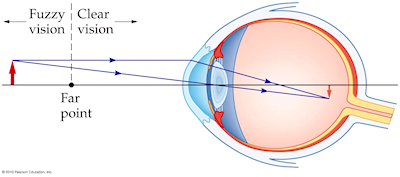 |
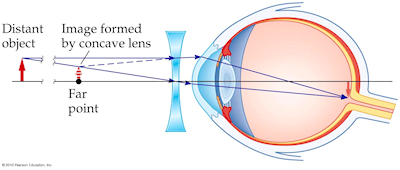 |
|
| The Farsighted Eye |
|---|
| uncorrected | corrected |
|---|
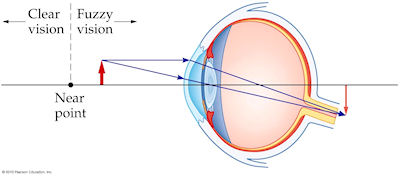 |
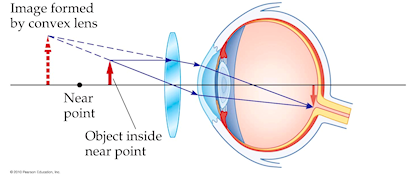 |
Chapter 36
- [Review] The wave equation 16.27

- [Module 16-7 flashback] Reflection and transmission


- Wave optics video
- Practice:
Try this additional example
Example #6
- Prepare:
Read textbook sections 35-1 and 35-2 before the next lecture
klm
Beam #1 is the incoming beam in the image below. Which beam would change if instead beam #5 were the incoming beam?
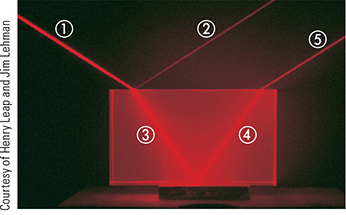 A. Beam #1
A. Beam #1
B. Beam #2
C. Beam #3
D. Beam #4
E. Beam #5
Answer
POP5 26.cq.11
 Is this person nearsighted or farsighted?
Is this person nearsighted or farsighted?
A. nearsighted
B. farsighted
C. neither
D. impossible to say
Answer
gc6 25.13
A person has a far point of 14 cm. What power contact lenses would the person need?
A. +7.14 D
B. +4.00 D
C. −7.14 D
D. −14.3 D
Answer
pse6 16.3a
A wave moving along the x-axis is described by
y(x,t) = 5.00e−(x + 5.00t)²
Determine the direction of motion.
A. +x direction
B. −x direction
C. not moving
Answer
pse6 16.3b
A wave moving along the x-axis is described by
y(x,t) = 5.00e−(x + 5.00t)²
Determine the wave speed.
A. 5.00 m/s
B. 6.74 mm/s
C. 10.0 m/s
D. 0 m/s
Answer
klm
A sound wave travels through wood into aluminum, a stiffer medium than wood. Is the reflected wave
in the wood inverted?
A. Yes
B. No
C. Can't say
Answer
Walker HS 13.CQ.93
Which wave is the superposition of the other two?

A. red
B. green
C. blue
D. none of them
Answer
 B. Beam #2
B. Beam #2
Beam #2 represents the partial reflection off the top surface when beam #1 is the incoming beam. When beam #5 becomes the incoming beam, beam #2 will originate at the right side, where beam #5 strikes the top surface, and head toward the top left.
A. nearsighted
The upright, reduced, virtual image of the man's face behind the lens indicates the lens is
diverging. Diverging lenses are used to correct nearsightedness. The converging lens for a farsighted person would produce an upright,
magnified, virtual image of the face. Here is a comparison, nearsighted on the left and farsighted
on the right:


C. −7.14 D

B. −x direction
The wave propagates in the +x direction if the function
is in the form f(x − vt), and in the −x direction if
the function is in the form f(x + vt).
A. 5.00 m/s
The wave speed is whatever number is in front of the t, as
long as the function is in the form f(x − vt).
B. No
The wave is traveling from a slow medium (wood) into a fast medium
(aluminum), and no inversion of the reflected wave occurs. This is similar to a light wave traveling
from a high index of refraction (glass) and into a low index of refraction (air); no inversion of the
reflected wave occurs.

C. blue
The blue wave has a larger displacement than the other two waves because its amplitude is the superposition of the other two.








 A. Beam #1
A. Beam #1 Is this person nearsighted or farsighted?
Is this person nearsighted or farsighted?
 B. Beam #2
B. Beam #2

